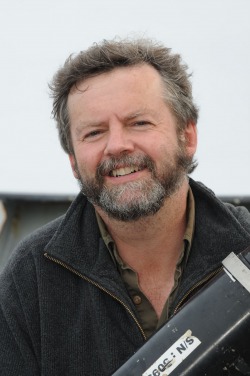Sustaining Marine Biodiversity in Canada and Globally Seminar

Sustaining Marine Biodiversity in Canada and Globally
DEPARTMENT OF OCEAN SCIENCES SEMINAR SERIES
Dr. Paul Snelgrove
Director, Canadian Healthy Oceans Network
Professor, Dept. of Ocean Sciences and Biology Dept., MUN
Human pressures on the global ocean continue to increase, creating new challenges
for sustainable ocean use and a recognized need to maintain ocean functions and
biodiversity. Ultimately, efforts to sustain marine biodiversity must consider at least
some closed area strategies and “smarter” sampling of the oceans, both of which
entail a wide range of scientific considerations. The Census of Marine Life provided
a framework for collaborative research in marine biodiversity that helped launch the
Canadian Healthy Oceans Network (CHONe), a national research program that is
uniting researchers to provide new insights into marine biodiversity and provide scientific guidelines for policy in ocean conservation and sustainable use. Our researchers have worked in shallow and deep-‐water habitats in the Atlantic, Pacific
and Arctic Oceans, from cutting edge, high definition imagery of deep-‐water corals,
sponges, and fishes to genetic samples and physical specimens of microbes, plankton, and sedimentary infauna. CHONe represents a potential model for national
academic and government partnership to advance biodiversity research structured
around interlinking themes that provide scientific input to advise policy needs. In this
presentation I present examples of research projects from CHONe’s three themes
of Marine Biodiversity, which links functional and species diversity to habitat complexity,
Ecosystem Function, which links biodiersity to ecosystem processes, and Population
Connectivity, which links population structure to spatial planning. For example, under
Marine Biodiversity CHONe established biodiversity research focus areas to link seafloor and benthic characteristics (e.g. rugosity, bathymetry, organic flux) to predict
benthic biodiversity. Within Ecosystem Function, CHONe scientists studied links between biodiversity and key functions related to ocean health (e.g. bioturbation,
biogeochemical fluxes) to try to understand how they respond to natural and anthropogenic disturbances. Population Connectivity has developed tools to address
how dispersal of marine organism early life stages influences patterns of diversity, resilience, and source/sink dynamics of species and biological communities. I
also discuss how we are working to integrate outcomes from these themes to identify
approaches to bridge science and policy, and communicate these results to the complex user groups who ultimately influence policy application.
Location: Challenger Room, Ocean Sciences Centre
Date: Thursday, January 23, 2014
Time: 3.30 – 4.30 pm
NOTICE: For people without transportation from campus, a shuttle will
leave from the Music Building entrance on parking lot 15B at 3.00 pm. It
will also return you to campus after the seminar.